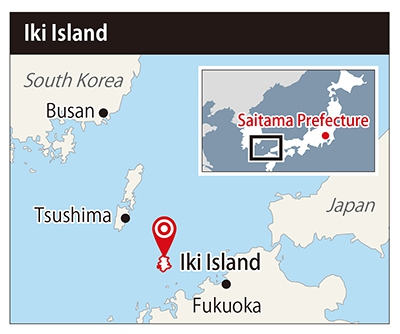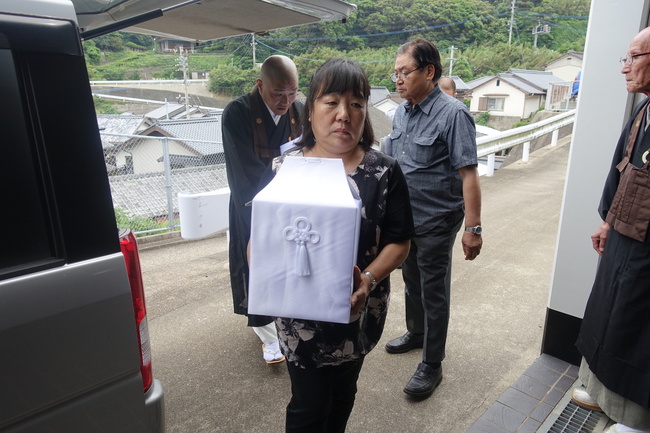Posted on : Jun.1,2018 16:39 KST
 |
|
A service held in honor of 131 Koreans shipwrecked Koreans at Tendokuji Temple, Iki Island, Nagasaki Prefecture, on May 31. (Cho Ki-weon, okyo correspondent)
|
Tendokuji Temple on Iki Island serves as temporary refuge for remains of 131 shipwrecked Koreans
“These people were supposed to return home and live happy lives. If they aren’t able to go home now, I think it’s appropriate for their remains to be temporarily stored here, where they washed ashore,” said Taichi Ikeda, a delegate to a monastic assembly representing the Soto school of Buddhism.
Ikeda was speaking during a Buddhist service at Tendokuji, a small temple on Iki Island in Nagasaki Prefecture, on the western end of Japan, on May 31. The service was held for 131 Koreans who are believed to have died during a shipwreck near Ashibe Harbor, on Iki Island, in 1945. They were on their way home after Korea’s liberation from Japanese colonial occupation.
 |
|
Iki Island
|
“I hope that the Korean remains will eventually be able to return home,” Ikeda said during his opening remarks for the service, during which the remains were laid to rest. On the day of the service, the Japanese Ministry of Health, Labor and Welfare transferred the remains of 131 Koreans from Konzoin Temple, in Saitama Prefecture, near Tokyo, to Iki Island in 39 white boxes. Iki is an island in the Strait of Korea, located between Kyushu and Tsushima, an island with which Koreans are more familiar.
After Korea’s liberation, on Aug. 15, 1945, 1.4 million Koreans who had been living in Japan returned to the Korean Peninsula. Every day, between ten and twenty thousand Koreans ready to go home congregated at the ports of Hakata in Fukuoka and Shimonoseki in Yamaguchi Prefecture. But there were not nearly enough ships departing for Korea. Quite a few Koreans paid brokers to arrange trips home in irregular vessels that were not always seaworthy.
The small wooden boats packed with Koreans set sail during typhoon season. Japan’s Kyushu region was battered by two large typhoons in 1945 – Mikurajaka from Sept. 17 to 18 and Akute on Oct. 11. Koreans who lost their lives in these storms were swept by the tides onto the shores of Iki and Tsushima islands. Locals collected some of the bodies that washed up on the beaches for burial. For more than three decades, the existence of these bodies was gradually forgotten by the world.
Attention focused on the remains of Koreans on Iki Island because of a Japanese individual named Munetoshi Fukagawa. As the human resources manager for Korean workers at Mitsubishi Heavy Industries in Hiroshima, Fukagawa had seen off 264 Korean workers at Hiroshima Station, and when he learned that none of them had returned home, he began tracking their whereabouts. In 1976, he dug up a burial site on Iki Island, convinced that the Koreans buried there had been workers pressed into service at Mitsubishi.
But despite his expectations, the bodies did not bear any Mitsubishi badges or exhibit any other connection with the company. He did find the body of a mother clutching a child. This led the Japanese government to excavate the bodies of Korean shipwreck victims at Tsushima in 1983 – one of the very few cases in which Japan has dug up Korean remains on its own initiative.
The remains that returned to Iki Island today consisted of 86 bodies found on Iki and 45 found on Tsushima. These remains circulated around four temples in Japan before being deposited at Konzoin in 2003. When Konzoin recently announced that it could no longer store the bodies, Tendokuji Temple on Iki Island volunteered to take over, which led to the bodies being returned to the island.
The Japanese Ministry of Health, Labor and Welfare had originally planned to move the Korean remains to a warehouse and then bury them in a mass grave at Chidorigafuchi National Cemetery in Tokyo. But when Tendokuji Temple volunteered its services, the Ministry agreed to let the remains be stored at this temple, which is closer to the Korean Peninsula.
 |
|
Participants in the service carefully transport the remains of the Korean shipwreck victims on May 31 at Tendokuji Temple, Iki Island, Nagasaki Prefecture.(Cho Ki-weon, okyo correspondent)
|
South Korean government needs to take measures for remains to “return home as soon as possible”
“We are calling on the governments of South Korea and Japan to take measures so that these remains can return home as soon as possible,” Tokudo Nishitani, the temple abbot, told The Hankyoreh.
A substantial number of bodies are presumed to remain on Iki and Tsushima islands. “In light of various circumstances near the excavation site in 1976, I think there’s another site where 76 Koreans were buried,” said Hiraku Taneda, who has long followed this issue while running a daily newspaper on Iki Island.
A memorial stone to Koreans currently stands near the area where Taneda believes more bodies are buried. The South Korean government has only brought back 423 bodies of Koreans, the remains of soldiers and civilians working for the military that had been stored at Yutenji, Tokyo.
Despite the South Korean government’s apathy, Tendokuji Temple has held a service for more than 20 years to comfort the spirits of Koreans who died right before they returned home.
“For a long time now, the South Korean and Japanese governments have said that now is not the right time. The ultimate destination of these remains is not Tendokuji, but their homeland,” said Mineo Masaki, who took part in digging up the remains on Iki in 1976.
By Cho Ki-weon, Tokyo correspondent reporting from Iki Island, Nagasaki Prefecture
Please direct comments or questions to [english@hani.co.kr]











